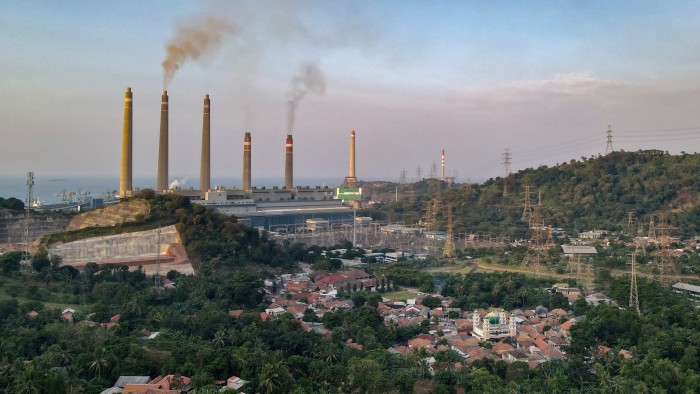Legal skills help unlock financing for sustainability ambitions

Roula Khalaf, Editor of the FT, selects her favourite stories in this weekly newsletter.
When John Yeap was a lawyer working in the energy sector in south-east Asia in the mid-1990s, he built a career advising governments on setting up coal-fired power plants — helping to fuel the stellar economic growth many countries in the region notched up in the years that followed.
But, since 2021, he and colleagues at law firm Pinsent Masons have been at the forefront of a plan to help those governments — in Indonesia, Vietnam and the Philippines — wind down some of the very same plants to kick-start their transition away from fossil fuels and towards renewable energy.
“I spent much of my time involved in work connected to building power plants but the needs of a low-carbon world mean I’m now devoting my life to getting some of them out of the system,” says Yeap, a former partner and head of the firm’s Asian energy team, and now a consultant to the firm, based in Hong Kong. “It’s quite a switch.”
Coal is the single biggest contributor to carbon dioxide emissions from the energy sector. In south-east Asia — home to the 10-member Association of Southeast Asian Nations (Asean) — the fuel has accounted for the largest share of the growth in total energy supply since 2000, according to the International Energy Agency. The IEA said in November that energy demand in south-east Asia was set to grow by around 3 per cent a year to 2030, with three-quarters of that increased demand being met by fossil fuels.
Energy analysts say facilitating a careful transition to renewables is imperative. “The conundrum that the [Asean] bloc’s leaders now face is how to secure energy supplies to develop the region’s economies, while also decarbonising them,” they noted at the World Economic Forum in January.
For Pinsent Masons, this has involved developing a financing structure for decommissioning of coal plants before the end of their useful life, while unlocking finance for renewables.
The firm was part of a consortium of advisers, including consultants at accountancy firm KPMG and engineering consultancy Mott MacDonald, that advised the Asian Development Bank on a funding vehicle known as an energy transition mechanism (ETM). Plans were agreed in November for the early retirement of coal-fired plants in south-east Asia, starting with Cirebon-1, a 660-megawatt plant in West Java, Indonesia.
Yeap and his team helped design and pilot the ETM through the creation of two funds. The first will pool funding from philanthropic and impact investors willing to provide debt more cheaply than normal market rates, to reduce the coal plants’ debt service costs — allowing the plants’ owners to repay the debt more quickly, in compensation for retiring their plants early. The second fund will bring together investors and lenders focused on renewable energy projects.
Structuring the ETM, to be implemented over several years, involved balancing various stakeholder interests. “A lot of these plants were built with robust contracts, so lenders and sponsors have pretty strong contractual frameworks in place,” Yeap explains.
“So, if the governments were to suddenly say ‘we are scrapping you’, they would end up in arbitration.”
Finding ways to satisfy various, often competing, interests is becoming an important factor in how lawyers approach environmental, social and governance (ESG) financing challenges.
One way to do this is to involve the beneficiaries of government funding in organising how social services are delivered.
Law firm King & Wood Mallesons (KWM) worked with a community of indigenous Australians to set up a governance structure to give local community leaders responsibility for funding that comes in from the government for various programmes — in line with the National Agreement on Closing the Gap.
A new Aboriginal-controlled body, set up in August 2022, ensures that the community of about 1,500 First Nations people living in Doomadgee, a remote town about 2,500km from Brisbane, plays a lead role in designing and implementing government services.
“We’d been listening to and led by community members for some time to help work out how services like housing, child safety, health, youth justice, could be delivered differently,” says Berkeley Cox, the KWM partner leading the project. Local leaders had felt their voices were not being heard, which fuelled mistrust between the community and the government.
The new governance structure was designed by community members with KWM’s support. It embeds the First Nations concept of cultural governance “that has developed over 60,000 years” into a company framework, explains Cox — for example, including membership requirements linked to ancestral family clans.
Satisfying different priorities was also central to work by Gilbert + Tobin. The law firm advised Commonwealth Bank of Australia on a financial structure under which the bank has prepaid A$1.7mn ($1.1mn) for carbon credits that will be generated by an agricultural rewilding project in Western Australia.
The bank’s prepayment of Australian carbon credit units (ACCUs) unlocks funds that two groups — Forever Wild, an ecological and social enterprise, and Corporate Carbon, an emissions-abatement venture — can use to buy the land more easily, under a pastoral lease, than if they had tried to obtain standard debt financing for such a purpose.
This allowed the groups to rear cattle in Western Australia using sustainable farming practices, while also rewilding other parts of the land, generating carbon credits to be repaid to the bank, says Ilona Millar, partner at Gilbert + Tobin in Sydney.
“One of the reasons why the bank was interested in this transaction was that this gives it access to a supply of ACCUs, which it will then be able to use with its institutional banking clients, or for its own ESG purposes,” she says. “For the two groups, it’s a way to achieve their conservation outcomes.”

Comments